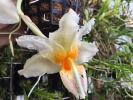|
|
|
|
|
| |
Flasks of
Stanhopea saccata 'MC7558' × self |
|
| |
|
|
| |
| Number: |
TN8628 |
| Name: |
Stanhopea saccata 'MC7558' × self
|
| Type: |
self (What's that?) |
|
Seed Donor: |
Troy C. Meyers
|
|
Click to Enlarge

Pod Parent Flower |
|
|
|
| |
Comments: Parent plant: One of the offspring from our TN5695 effort of 2007.
For additional origin/habitat information supplied courtesy of
Charles and Margaret Baker, see further below, near the bottom of this page.
|
Temperatures we attempt to use in the lab & greenhouse:
| For Species: |
|
Summer, Autumn: days average 85°F, nights 63°F; best fit is Warm-Intermediate 87-64°F
(Source:
Baker's Web OSC) |
| For Species: |
|
Spring: days average 90°F, nights 62°F; best fit is Warm-Intermediate 87-64°F
(Source:
Baker's Web OSC) |
| For Species: |
|
Winter: days average 88°F, nights 58°F; best fit is Intermediate 83-60°F
(Source:
Baker's Web OSC) |
|
About the name...
| Etymology of |
saccata |
|
From Latin "saccatus" sack-shaped.
(Source:
Mayr & Schmucker 1998) |
| Etymology of |
Stanhopea |
|
In honor of Philip Henry, 4th Earl of Stanhope, president of the London Medico-Botanical Society during the early part of the 19th century.
(Source:
Pridgeon 1992) |
| Pronunciation of |
saccata |
|
sa-KAH-ta
(Source:
Hawkes 1978) |
| Pronunciation of |
Stanhopea |
|
stan-HOPE-ee-ah
(Source:
Pridgeon 1992) |
|
If you would like to direct someone to this web page, please copy and paste this URL into your email:
http://troymeyers.com/d?018628
| Ordering Information |
| You are not currently logged in. |
|
You must be a registered user and be logged in to reserve a flask or place a notification request. Please log in:
|
|
|
|
|
|
| |
The origin/habitat information below is supplied courtesy of Charles and Margaret Baker
The following information is based on the name of the plant provided by the donor, and assumes that the name is correct. If the plant has been misidentified, then the following information may not be correct.
This text is copyrighted by the Bakers and may not be reproduced without permission.
ORIGIN/HABITAT: Southern Mexico southward through Guatemala to El Salvador
is currently considered the range of habitat. S. saccata is usually found
at 1300-1650 ft. (400-500 m) on the Pacific slopes in seasonally dry oak
woods, but in El Salvador, plants have been collected on Cerro Montecristo
at 3300 ft. (1000 m) and at Cumbre del Bálsamo and on Cerro Grande de
Apaneca at 2950 ft. (900 m). In Guatemala, plants grow on trees in humid
forests at elevations to 4600 ft. (1400 m). Ames and Correll (1985) report
that plants are uncommon in Mexico, Guatemala, and El Salvador.
Jenny (1993(3)-Schlechteriana) indicated that in Mexico Stanhopea saccata
occurs in the southern part of the Isthmus of Tehuantepec and that
anything collected further north is probably Stanhopea radiosa. He states
that a Stanhopea found in the State of Chiapas near the Mexican border
with Guatemala had blossoms which were twice the size of a normal
Stanhopea saccata. There are several speculations about the possible cause
for the difference in flower size, but so far, they are only speculations.
More about this information and the Bakers...
|
|
|
| |
|
|
|